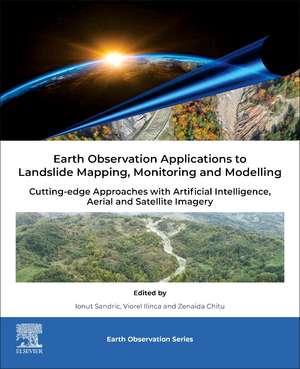Earth Observation Applications to Landslide Mapping, Monitoring and Modeling: Cutting-edge Approaches with Artificial Intelligence, Aerial and Satellite Imagery: Earth Observation
Editat de Viorel Ilinca, Zenaida Chituen Limba Engleză Paperback – 8 noi 2024
- Recent developments in landslide monitoring and mapping algorithms
- Provides clear and detailed case studies and methods that can be easily replicated and implemented in landslide monitoring systems
- Provides detailed methods for applying research to landslide monitoring and mapping
Preț: 920.66 lei
Preț vechi: 1070.54 lei
-14% Nou
Puncte Express: 1381
Preț estimativ în valută:
176.19€ • 183.27$ • 145.46£
176.19€ • 183.27$ • 145.46£
Carte tipărită la comandă
Livrare economică 12-26 aprilie
Preluare comenzi: 021 569.72.76
Specificații
ISBN-13: 9780128238684
ISBN-10: 0128238682
Pagini: 400
Ilustrații: 200 illustrations (120 in full color)
Dimensiuni: 191 x 235 mm
Greutate: 0.72 kg
Editura: ELSEVIER SCIENCE
Seria Earth Observation
ISBN-10: 0128238682
Pagini: 400
Ilustrații: 200 illustrations (120 in full color)
Dimensiuni: 191 x 235 mm
Greutate: 0.72 kg
Editura: ELSEVIER SCIENCE
Seria Earth Observation
Public țintă
Geologist, geomorphologists, researchers and practitioners working in environmental modelling and remote sensing Environmental engineers and government and NGOs working on prevention of landslidesCuprins
Section 1: Introduction
1. A review of UAV-based data applications for landslide mapping and monitoring
2. A review of the state-of-the-art use of satellite Earth observation data for landslide mapping and monitoring
Section 2: Satellite data in landslide mapping and
monitoring
3. On the use of the EGMS data for studying landslides in Great Britain
4. Deciphering the kinematics of urban landslides through SAR imagery analysis
5. Artificial intelligence applications for landslide mapping/monitoring on satellite EO data
6. Mapping landslides on Earth, Moon, and Mars using satellite imagery and deep learning techniques
Section 3: Drone applications for landslide mapping
and monitoring
7. Landslide volume and runoff monitoring using UAV photogrammetry
8. Landslide 3D reconstruction and monitoring using oblique and nadiral drone aerial imagery
9. Geomorphic monitoring and assessment of debris flows using drone-based structure from motion
10. Machine learning and object-based image analysis for landside mapping using UAV-derived data
11. Estimating kinematic uncertainties of landslides using UAV time series
12. Detailed landslide kinematics mapping using short-term UAV time-series. Case study: Livadea landslide, Romania
Section 4: EO data assimilations in landslide susceptibility, hazard mapping and risk assessment
13. Building landslide inventory with LiDAR data and deep learning
14 Landslide susceptibility mapping using machine-learning algorithms and earth observation data
15. Microwave remote sensing for investigating hydrological preconditions triggering landslides: a case study: Ialomita Subcarpathians, Romania
16. Use of UAV imagery for the detection and measurement of damages to road networks in landslide areas
Section 5: Future challenges and future outlook
17. Mapping the existing challenges and pathway forward
1. A review of UAV-based data applications for landslide mapping and monitoring
2. A review of the state-of-the-art use of satellite Earth observation data for landslide mapping and monitoring
Section 2: Satellite data in landslide mapping and
monitoring
3. On the use of the EGMS data for studying landslides in Great Britain
4. Deciphering the kinematics of urban landslides through SAR imagery analysis
5. Artificial intelligence applications for landslide mapping/monitoring on satellite EO data
6. Mapping landslides on Earth, Moon, and Mars using satellite imagery and deep learning techniques
Section 3: Drone applications for landslide mapping
and monitoring
7. Landslide volume and runoff monitoring using UAV photogrammetry
8. Landslide 3D reconstruction and monitoring using oblique and nadiral drone aerial imagery
9. Geomorphic monitoring and assessment of debris flows using drone-based structure from motion
10. Machine learning and object-based image analysis for landside mapping using UAV-derived data
11. Estimating kinematic uncertainties of landslides using UAV time series
12. Detailed landslide kinematics mapping using short-term UAV time-series. Case study: Livadea landslide, Romania
Section 4: EO data assimilations in landslide susceptibility, hazard mapping and risk assessment
13. Building landslide inventory with LiDAR data and deep learning
14 Landslide susceptibility mapping using machine-learning algorithms and earth observation data
15. Microwave remote sensing for investigating hydrological preconditions triggering landslides: a case study: Ialomita Subcarpathians, Romania
16. Use of UAV imagery for the detection and measurement of damages to road networks in landslide areas
Section 5: Future challenges and future outlook
17. Mapping the existing challenges and pathway forward














